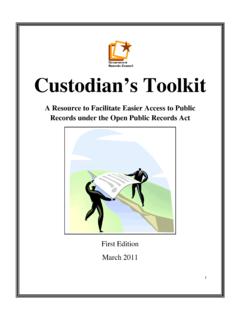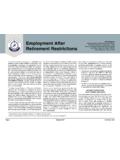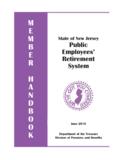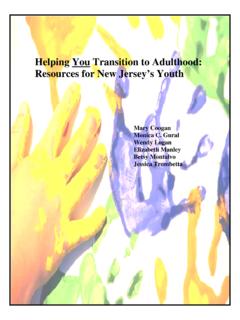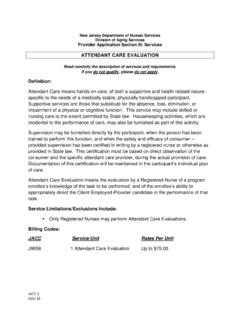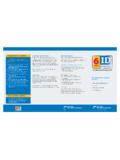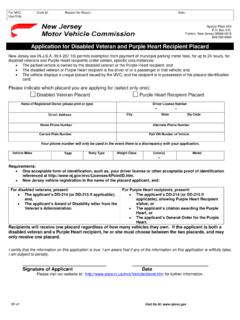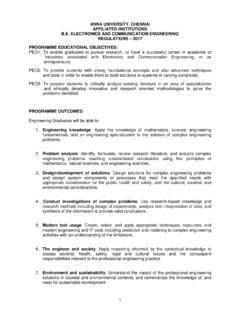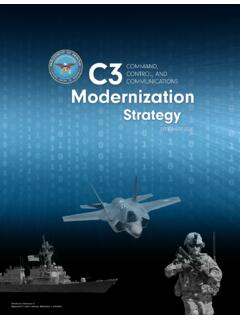Transcription of Kindergarten through Grade 12 - Government of New Jersey
1 2020 New Jersey Student Learning Standards Science Kindergarten through Grade 12. December 2020. Table of Contents Introduction ..1. Standards 14. Grades Kindergarten through 5 .. 14. Kindergarten .. 14. Grade 1 .. 26. Grade 2 .. 36. Grade 3 .. 48. Grade 4 .. 66. Grade 5 .. 82. Grades 6 through 98. Physical Science .. 98. Life Science .. 114. Earth and Space Sciences .. 130. Engineering, Technology and Applications of Science .. 142. Grades 9 through 145. Physical Science .. 145. Life Science .. 162. Earth and Space Sciences .. 181. Engineering, Technology and Applications of Science .. 198.
2 Introduction 2020 New Jersey Student Learning Standards Science Introduction Science Scientific and technological advances have proliferated and now permeate most aspects of life in the 21st century. It is increasingly important that all members of our society develop an understanding of scientific and engineering concepts and processes. Learning how to construct scientific explanations and how to design evidence-based solutions provides students with tools to think critically about personal and societal issues and needs. Students can then contribute meaningfully to decision-making processes, such as discussions about climate change, new approaches to health care, and innovative solutions to local and global problems.
3 Mission All students will possess an understanding of scientific concepts and processes required for personal decision- making, participation in civic life, and preparation for careers in STEM fields (for those that chose). Vision Prepare students to become scientifically literate individuals who can effectively: Apply scientific thinking, skills, and understanding to real-world phenomena and problems;. Engage in systems thinking and modeling to explain phenomena and to give a context for the ideas to be learned;. Conduct investigations, solve problems, and engage in discussions;. Discuss open-ended questions that focus on the strength of the evidence used to generate claims.
4 Read and evaluate multiple sources, including science-related magazine and journal articles and web-based resources to gain knowledge about current and past science problems and solutions and develop well- reasoned claims; and Communicate ideas through journal articles, reports, posters, and media presentations that explain and argue. Spirit and Intent The New Jersey Student Learning Standards for Science (NJSLS-S) describe the expectations for what students should know and be able to do as well as promote three-dimensional science instruction across the three science domains ( , physical sciences, life science, Earth and space sciences).
5 From the earliest grades, the expectation is that students will engage in learning experiences that enable them to investigate phenomena, design solutions to problems, make sense of evidence to construct arguments, and critique and discuss those arguments (in appropriate ways relative to their Grade level). The foundation of the NJSLS-S reflects three dimensions science and engineering practices, disciplinary core ideas, and crosscutting concepts. The performance expectations are derived from the interplay of these three dimensions. It is essential that these three components are integrated into all learning experiences.
6 Within each standard document, the three dimensions are intentionally presented as integrated components to foster sensemaking and designing solutions to problems. Because the NJSLS-S is built on the notions of coherence and contextuality, each of the science and engineering practices and crosscutting concepts appear multiple times across New Jersey Department of Education December 2020 Page 1 of 200. Introduction topics and at every Grade level. Additionally, the three dimensions should be an integral part of every curriculum unit and should not be taught in isolation. Three Dimensions of NJSLS-S.
7 The performance expectations reflect the three dimensions and describe what students should know and be able to do. In layman's terms, they are the standards. They are written as statements that can be used to guide assessment and allow for flexibility in the way that students are able to demonstrate proficiency. The example below is provided to illustrate the interconnected nature of the NJSLS-S components. Disciplinary Core Ideas and Performance Expectations Disciplinary Core Idea Performance Expectation Patterns of the apparent motion of the sun, Develop and use a model of the Earth-sun- the moon, and stars in the sky can be moon system to describe the cyclic patterns of observed, described, predicted, and lunar phases, eclipses of the sun and moon, and explained with models.
8 Seasons. Science and Engineering Practices Developing and Using Models Develop and use a model to describe phenomena. Crosscutting Concepts Scale, Proportion, and Quantity Time, space, and energy phenomena can be observed at various scales using models to study systems that are too large or too small. Becoming familiar with the science practices and crosscutting concepts is a critically important first step in designing learning experiences reflective of the three dimensions. A description of each of the science and engineering practices and the cross-cutting concepts can be found in the next sections.
9 Further, for students to develop proficiency of the NJSLS-S, they will need to engage in learning experiences that are meaningful, cumulative, and progressive. Learning experiences designed to be meaningful, go beyond reading about science concepts and provide opportunities for students to be active learners and make sense of ideas. Cumulative learning experiences provide opportunities for students to use and build on ideas that they have learned in previous units. Progressive learning experiences provide multiple occasions for students to engage in ways that enable them to improve their construction of explanations and solutions over time by iteratively assessing them, elaborating on them, and holding them up to critique and evidence.
10 New Jersey Department of Education December 2020 Page 2 of 200. Introduction Scientific and Engineering Practices Asking Questions and Defining Problems A practice of science is to ask and refine questions that lead to descriptions and explanations of how the natural and designed world works and which can be empirically tested. Engineering questions clarify problems to determine criteria for successful solutions and identify constraints to solve problems about the designed world. Both scientists and engineers also ask questions to clarify the ideas of others. Planning and Carrying Out Investigations Scientists and engineers plan and carry out investigations in the field or laboratory, working collaboratively as well as individually.
